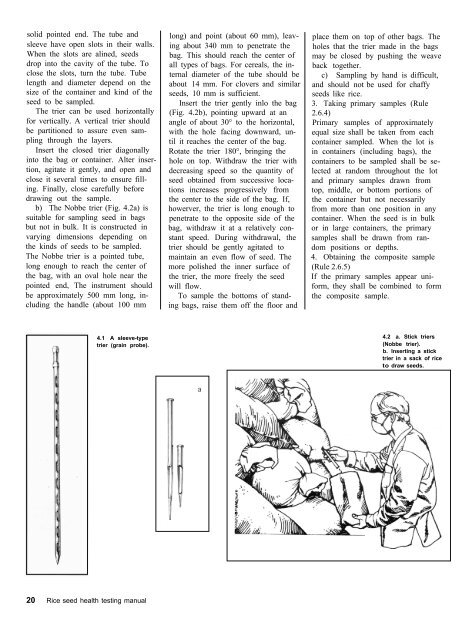A manual of rice seed health testing - IRRI books - International Rice ...
A manual of rice seed health testing - IRRI books - International Rice ...
A manual of rice seed health testing - IRRI books - International Rice ...
- No tags were found...
You also want an ePaper? Increase the reach of your titles
YUMPU automatically turns print PDFs into web optimized ePapers that Google loves.
solid pointed end. The tube and<br />
sleeve have open slots in their walls.<br />
When the slots are alined, <strong>seed</strong>s<br />
drop into the cavity <strong>of</strong> the tube. To<br />
close the slots, turn the tube. Tube<br />
length and diameter depend on the<br />
size <strong>of</strong> the container and kind <strong>of</strong> the<br />
<strong>seed</strong> to be sampled.<br />
The trier can be used horizontally<br />
for vertically. A vertical trier should<br />
be partitioned to assure even sampling<br />
through the layers.<br />
Insert the closed trier diagonally<br />
into the bag or container. Alter insertion,<br />
agitate it gently, and open and<br />
close it several times to ensure filling.<br />
Finally, close carefully before<br />
drawing out the sample.<br />
b) The Nobbe trier (Fig. 4.2a) is<br />
suitable for sampling <strong>seed</strong> in bags<br />
but not in bulk. It is constructed in<br />
varying dimensions depending on<br />
the kinds <strong>of</strong> <strong>seed</strong>s to be sampled.<br />
The Nobbe trier is a pointed tube,<br />
long enough to reach the center <strong>of</strong><br />
the bag, with an oval hole near the<br />
pointed end, The instrument should<br />
be approximately 500 mm long, including<br />
the handle (about 100 mm<br />
long) and point (about 60 mm), leaving<br />
about 340 mm to penetrate the<br />
bag. This should reach the center <strong>of</strong><br />
all types <strong>of</strong> bags. For cereals, the internal<br />
diameter <strong>of</strong> the tube should be<br />
about 14 mm. For clovers and similar<br />
<strong>seed</strong>s, 10 mm is sufficient.<br />
Insert the trier gently inlo the bag<br />
(Fig. 4.2b), pointing upward at an<br />
angle <strong>of</strong> about 30° to the horizontal,<br />
with the hole facing downward, until<br />
it reaches the center <strong>of</strong> the bag.<br />
Rotate the trier 180°, bringing the<br />
hole on top. Withdraw the trier with<br />
decreasing speed so the quantity <strong>of</strong><br />
<strong>seed</strong> obtained from successive locations<br />
increases progressively from<br />
the center to the side <strong>of</strong> the bag. If,<br />
howerver, the trier is long enough to<br />
penetrate to the opposite side <strong>of</strong> the<br />
bag, withdraw it at a relatively constant<br />
speed. During withdrawal, the<br />
trier should be gently agitated to<br />
maintain an even flow <strong>of</strong> <strong>seed</strong>. The<br />
more polished the inner surface <strong>of</strong><br />
the trier, the more freely the <strong>seed</strong><br />
will flow.<br />
To sample the bottoms <strong>of</strong> standing<br />
bags, raise them <strong>of</strong>f the floor and<br />
place them on top <strong>of</strong> other bags. The<br />
holes that the trier made in the bags<br />
may be closed by pushing the weave<br />
back together.<br />
c) Sampling by hand is difficult,<br />
and should not be used for chaffy<br />
<strong>seed</strong>s like <strong>rice</strong>.<br />
3. Taking primary samples (Rule<br />
2.6.4)<br />
Primary samples <strong>of</strong> approxirnately<br />
equal size shall be taken from each<br />
container sampled. When the lot is<br />
in containers (including bags), the<br />
containers to be sampled shall be selected<br />
at random throughout the lot<br />
and primary samples drawn from<br />
top, middle, or bottom portions <strong>of</strong><br />
the container but not necessarily<br />
from more than one position in any<br />
container. When the <strong>seed</strong> is in bulk<br />
or in large containers, the primary<br />
samples shall be drawn from random<br />
positions or depths.<br />
4. Obtaining the composite sample<br />
(Rule 2.6.5)<br />
If the primary samples appear uniform,<br />
they shall be combined to form<br />
the composite sample.<br />
4.1 A sleeve-type<br />
trier (grain probe).<br />
4.2 a. Stick triers<br />
(Nobbe trier).<br />
b. Inserting a stick<br />
trier in a sack <strong>of</strong> <strong>rice</strong><br />
to draw <strong>seed</strong>s.<br />
20 <strong>Rice</strong> <strong>seed</strong> <strong>health</strong> <strong>testing</strong> <strong>manual</strong>

















